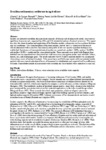Use este identificador para citar ou linkar para este item:
http://www.alice.cnptia.embrapa.br/alice/handle/doc/864627Registro completo de metadados
| Campo DC | Valor | Idioma |
|---|---|---|
| dc.contributor.author | BERNARDI, A. C. de C. | pt_BR |
| dc.contributor.author | OLIVEIRA, P. P. A. | pt_BR |
| dc.contributor.author | MONTE, M. B. de | pt_BR |
| dc.contributor.author | POLIDORO, J. C. | pt_BR |
| dc.contributor.author | SOUZA-BARROS, F. | pt_BR |
| dc.date.accessioned | 2014-06-01T03:06:04Z | - |
| dc.date.available | 2014-06-01T03:06:04Z | - |
| dc.date.created | 2010-10-19 | pt_BR |
| dc.date.issued | 2010 | pt_BR |
| dc.identifier.citation | In: WORLD CONGRESS OF SOIL SCIENCE, 19., 2010, Brisbane. Soil solutions for a changing world - Anais. Brisbane: ASSSI, 2010 | pt_BR |
| dc.identifier.uri | http://www.alice.cnptia.embrapa.br/alice/handle/doc/864627 | pt_BR |
| dc.description | Zeolites are hydrated crystalline aluminosilicate minerals of alkaline and alkaline earth metals, structured in rigid three dimension nets, organized by AlO4 and SiO4 tetrahedral and are of natural occurrence. This report describes the characterization and application of the Brazilian zeolitic sedimentary rock as a release fertilizer and soil conditioner. The characterization of the head samples showed that it is composed of the zeolite stilbite intermixed with a smectitic clay mineral, and quartz. A low-cost quartz separation technique was established. Enrichment of concentrated natural zeolite was carried out: zeolite + KNO3, zeolite + K2HPO4 and zeolite + H3PO4 + apatite and the concentrated zeolite. These materials were tested with Rangpur lime rootstock and an experiment was also carried out with successive crops grown on the same substrate: lettuce, tomato, rice, and Andropogon grass. The results indicated that N, P and K enriched zeolite was an adequate slow-release source of nutrients to plants. Other green house and field experiments with concentrated zeolite applied with urea showed reduction of losses of ammonia by volatilization and improved in N use efficiency by maize. Concentrated zeolite also increased water retention and the available water capacity of a sand soil. | pt_BR |
| dc.language.iso | por | pt_BR |
| dc.rights | openAccess | pt_BR |
| dc.subject | Stilbite | pt_BR |
| dc.subject | Slow-release fertilizer | pt_BR |
| dc.subject | N losses | pt_BR |
| dc.subject | Water retention curve | pt_BR |
| dc.subject | Zeolite | pt_BR |
| dc.title | Brazilian sedimentary zeolite use in agriculture. | pt_BR |
| dc.type | Artigo em anais e proceedings | pt_BR |
| dc.date.updated | 2014-06-01T03:06:04Z | pt_BR |
| dc.subject.nalthesaurus | available water capacity | pt_BR |
| riaa.ainfo.id | 864627 | pt_BR |
| riaa.ainfo.lastupdate | 2014-05-30 | pt_BR |
| dc.contributor.institution | ALBERTO CARLOS DE CAMPOS BERNARDI, CPPSE; PATRICIA PERONDI ANCHAO OLIVEIRA, CPPSE; MARISA B. DE MELO MONTE, CETEM/RIO DE JANEIRO/RJ; JOSE CARLOS POLIDORO, CNPS; FERNANDO SOUZA BARROS, INSTITUTO DE FÍSICA/RIO DE JANEIRO-RJ. | pt_BR |
| Aparece nas coleções: | Artigo em anais de congresso (CPPSE)  | |
Arquivos associados a este item:
| Arquivo | Descrição | Tamanho | Formato | |
|---|---|---|---|---|
| PROCI2010.00105.pdf | 271,36 kB | Adobe PDF |  Visualizar/Abrir |









